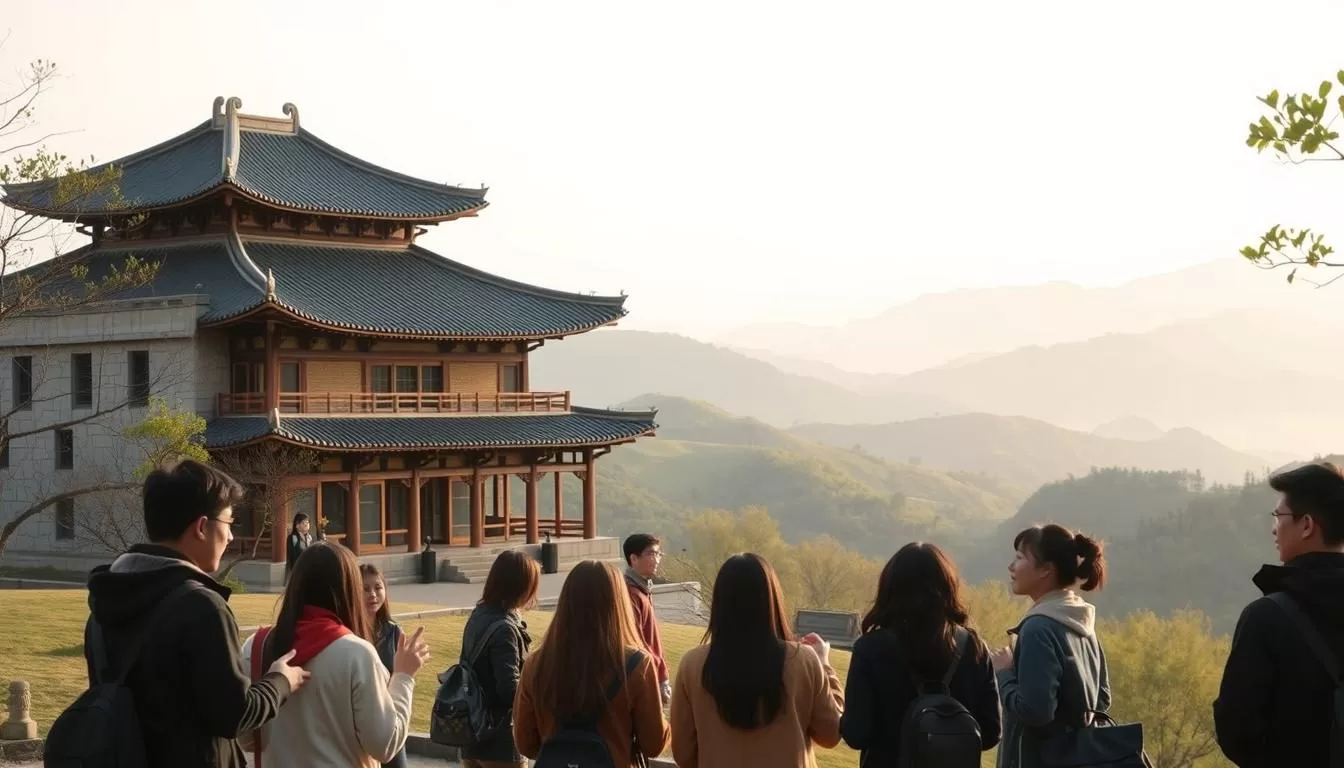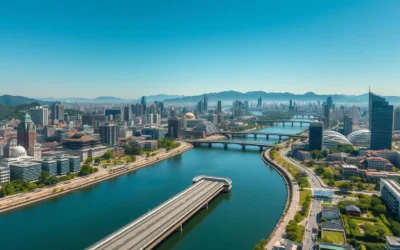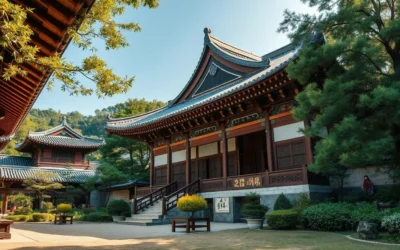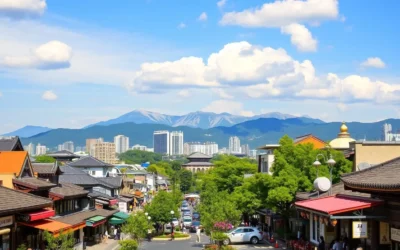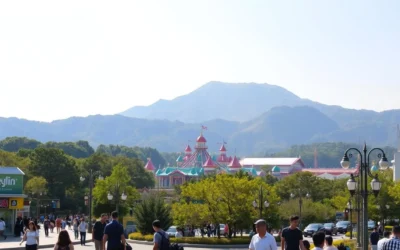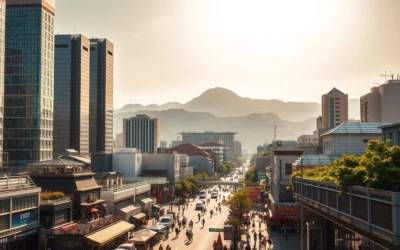✓ Accommodations✓ Flights✓ Rental Cars
You’re about to explore the fascinating world of languages in Gangwon Province, a region in South Korea known for its unique dialect and rich cultural heritage. The Korean language, with its distinct grammar and alphabet, known as Hangul, is not just a means of communication but a window into the nation’s soul.
As you delve into the linguistic landscape of this beautiful region, you’ll discover how the dialect of Gangwon Province differs from Standard Korean and other regional dialects. You’ll gain insights into how geographical isolation and historical events have shaped the local language and culture over time.
This exploration will enhance your understanding of how language reflects the region’s traditions, natural environment, and historical experiences, making your travel or cultural appreciation experience even more meaningful.
The Linguistic Landscape of South Korea
As you explore South Korea, you’ll discover a rich linguistic landscape shaped by its history and culture. The country’s language profile is characterized by the dominance of the Korean language, with Standard Korean serving as the foundation for formal communication, education, and media.
Korean as the National Language
Korean is the official language of South Korea, spoken by virtually all citizens across the peninsula. With a high literacy rate of 99% and internet penetration of 97%, the Korean language has become a unifying factor for the country. Standard Korean, based on the Seoul dialect, is used in official contexts, ensuring a common language across different regions.
Overview of Regional Dialects
South Korea is home to six main dialects: Seoul & Gyeonggi, Gangwon, Chungcheong, Gyeongsang, Jeolla, and Jeju. Each dialect has distinctive features, offering insights into regional cultures. For instance, the Gangwon dialect is known for its unique vocabulary and pronunciation.
| Dialect Region | Distinctive Features |
|---|---|
| Seoul & Gyeonggi | Standard Korean basis, used in media and education |
| Gangwon | Unique vocabulary and pronunciation |
| Gyeongsang | Distinctive accent and vocabulary |
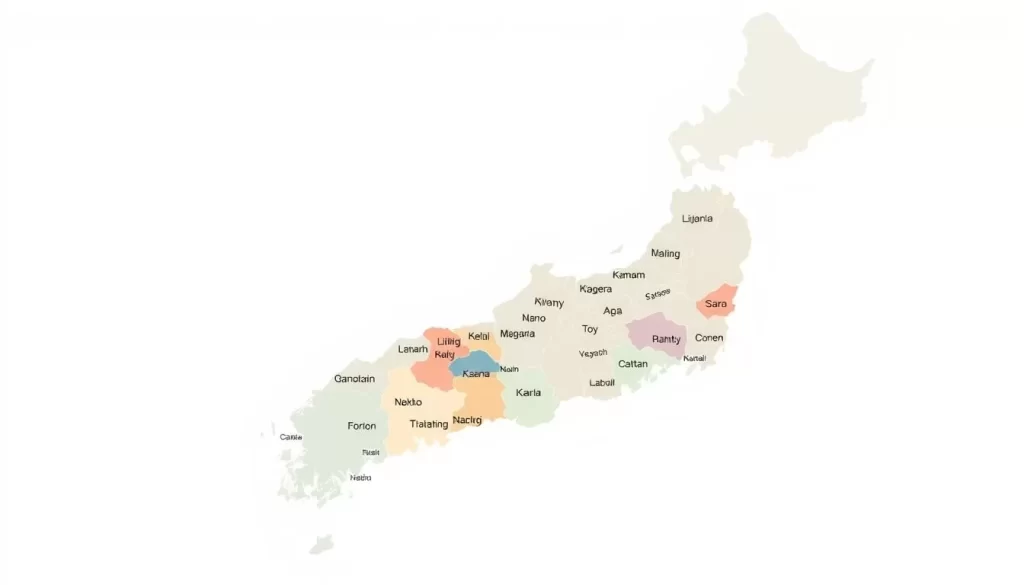
Standard Korean (Pyojuneo): The Foundation
As you explore the linguistic landscape of South Korea, you’ll discover that Standard Korean, or Pyojuneo, serves as the foundation of modern communication. This standardized form of the Korean language is crucial for ensuring consistency across various domains, including education, government, and media.
Origins and Development
The development of Standard Korean is deeply rooted in the history of the Korean language. The journey began over 2,000 years ago with the use of Chinese characters for writing. A significant milestone was achieved in the 15th century when King Sejong introduced Hangul, a phonetic alphabet designed to make writing accessible to everyone. This revolutionary script, known as Hunminjeongeum, consisted of 24 letters and was remarkably easy to learn.
The Gyeonggi dialect, which is closely related to the Seoul dialect, forms the basis of Pyojuneo. Approximately 70% of its vocabulary was adopted as the standard, creating a consistent linguistic framework.
Role in Education and Media
Standard Korean plays a vital role in education, government offices, and media, serving as the benchmark for formal communication. Its use ensures that information is conveyed consistently and accurately across the nation. In educational institutions, Standard Korean is the primary language of instruction, providing students with a solid foundation in the language.
The media also relies heavily on Standard Korean, using it in news broadcasts, publications, and other forms of content. This helps maintain a unified language standard, facilitating clear communication among people from different regions.
| Domain | Role of Standard Korean | Benefits |
|---|---|---|
| Education | Primary language of instruction | Provides a solid foundation in the language |
| Government | Used in official documents and communications | Ensures clarity and consistency in governance |
| Media | Used in news broadcasts and publications | Maintains a unified language standard |

Gangwon Province: Regional Identity Through Language
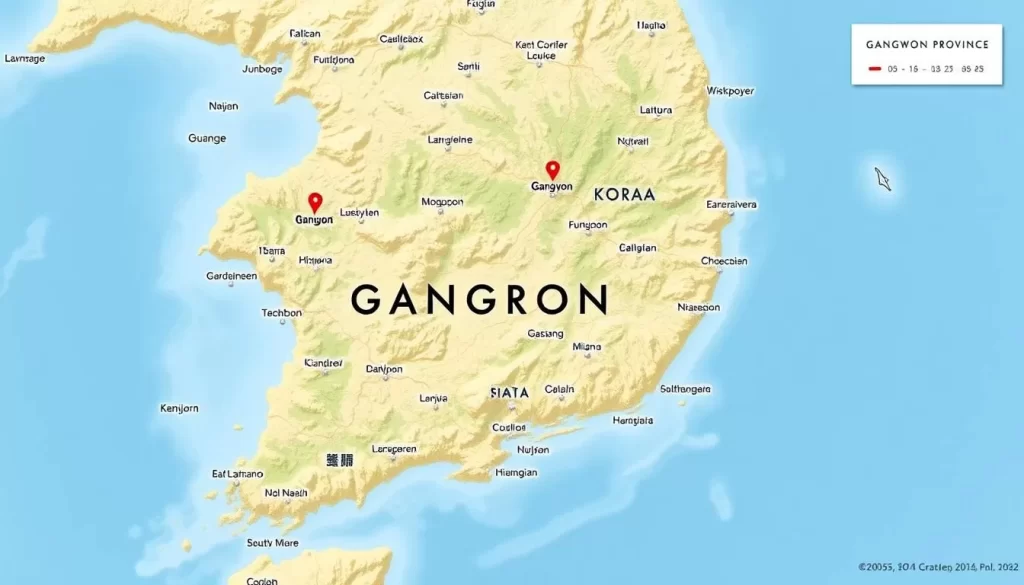
Gangwon Province’s regional identity is deeply intertwined with its language, shaped by the province’s rugged terrain. As you explore this unique dialect, you’ll gain insights into the region’s history, culture, and traditions.
Geographical and Cultural Context
Gangwon Province is characterized by its mountainous landscape, which has historically isolated communities and influenced the development of its distinct dialect. The region’s agricultural traditions, natural landscapes, and historical development have all contributed to its unique linguistic patterns. You’ll discover how the province’s geography has played a significant role in shaping the local language.
Distinctive Features of the Gangwon Dialect
The Gangwon dialect is distinguished by specific phonological features, such as the change from ㅆ to ㅅ (e.g., 싸움 (ssaum, fight) becomes 사움 (saum)) and the shift from ㅏ to ㅓ at the end of sentences (e.g., 좋아 (joa, good) becomes 좋어 (joe, good)). These changes give the Gangwon dialect a softer, more rustic feel compared to Standard Korean. The distinctive features of the Gangwon dialect reflect the region’s cultural identity.
Common Expressions and Vocabulary
The Gangwon dialect includes unique vocabulary and expressions that reflect the region’s connection to nature and rural lifestyle. Terms like “머스마” (meoseuma) for “boy” and “할마시” (halmasi) for “grandmother” are examples of the region’s linguistic heritage. The dialect preserves older Korean terms that have fallen out of common usage in other regions, serving as a linguistic time capsule.
As you learn more about the Gangwon Province dialect, you’ll appreciate the rich cultural context and history embedded in the language. The unique characteristics of the Gangwon dialect make it a fascinating aspect of Korea’s linguistic diversity.
Comparing Gangwon Dialect with Other Korean Dialects
As you explore the linguistic diversity of South Korea, comparing the Gangwon dialect with other dialects reveals the rich tapestry of the Korean language. The Gangwon dialect, while having its unique characteristics, is part of a larger linguistic landscape that includes various other dialects spoken across different regions.
Seoul and Gyeonggi Dialect
The Seoul and Gyeonggi dialect, often considered the standard Korean dialect, serves as the foundation for modern Korean language education. This dialect is prevalent in media, including TV shows, news channels, and Korean dramas. In comparison, the Gangwon dialect has a softer, more drawn-out speech pattern, contrasting with the faster pace of the Seoul dialect.
Neighboring Regional Dialects
Neighboring dialects, such as the Chungcheong dialect to the west and the Gyeongsang dialect to the south, have distinct features. The Gyeongsang dialect is known for its “strong” or “manly” quality, with brisk and sometimes abrupt intonation. The Gangwon dialect differs from these neighboring dialects, showcasing the diversity of regional languages.
Mutual Intelligibility Among Dialects
Despite their differences, most Korean dialects are mutually intelligible to a great extent. This is largely due to the education system emphasizing standard Korean and the influence of mass media. As a result, most Koreans can understand the Gangwon dialect, even if it’s not their native dialect.
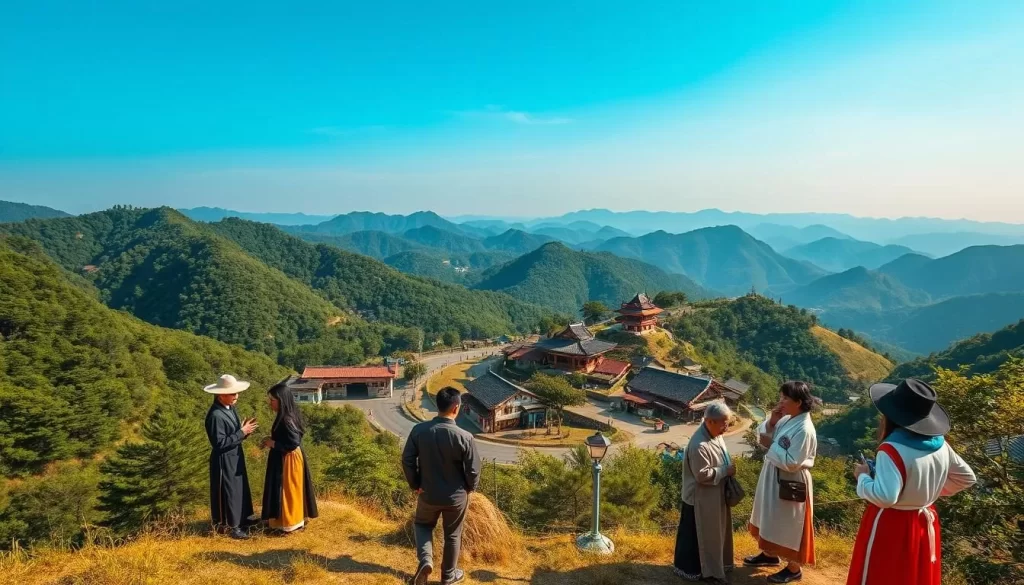
- The Gangwon dialect’s unique features are highlighted when compared to other major Korean dialects.
- Education and media exposure have significantly influenced dialect comprehension across South Korea.
- Regional stereotypes are often associated with different dialects, including the Gangwon dialect’s association with countryside simplicity.
Historical Development of the Korean Language in Gangwon
Understanding the evolution of the Korean language in Gangwon Province requires a look into its rich historical context. The region’s unique geography and historical events have significantly influenced the development of its dialect.
Pre-Modern Language Evolution
The Middle Korean period, spanning from the 11th to the 16th century, was crucial in laying the groundwork for modern Korean. Gangwon Province, with its mountainous terrain, preserved distinctive linguistic features due to its relative isolation. Historical kingdoms and regional divisions also played a role in shaping the Gangwon dialect.
| Period | Linguistic Developments |
|---|---|
| 11th-16th century | Middle Korean period; foundation for modern Korean |
| 17th century | Significant language transformation; incorporation of new vocabulary |
Modern Linguistic Changes
The 20th century brought substantial changes to the Korean language in Gangwon Province, influenced by Japanese colonization, the Korean War, and rapid industrialization. These events led to linguistic divergence between North and South Korea, affecting Gangwon Province uniquely due to its position as a border province.
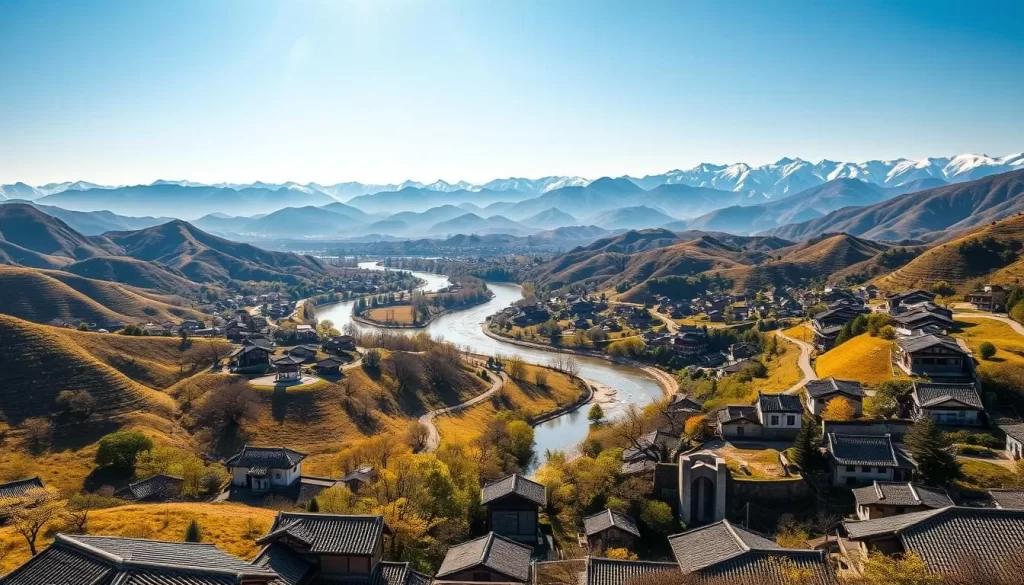
Modern developments, including improvements in transportation, education standardization, and media influence, have gradually modified the traditional Gangwon dialect. Understanding these changes provides insight into the current state of the Korean language in the region.
Cultural Influences on Language in Gangwon Province
You’ll find that the language in Gangwon Province is intricately linked with its rich cultural traditions. The province’s unique cultural identity is deeply embedded in everyday speech, with many traditions influencing the local dialect. Major holidays like Lunar New Year and Chuseok shape language by introducing specific terms and phrases into daily use, emphasizing family gatherings and cultural heritage.
Traditional Customs and Their Linguistic Impact
Traditional customs related to agriculture, fishing, and mountain life have significantly shaped the vocabulary in the Gangwon dialect. For instance, the community’s reliance on agriculture has led to the development of specialized terminology related to farming practices. Additionally, folk beliefs and shamanic practices have contributed to distinctive expressions that reflect the community’s cultural values, such as respect for nature and family relationships.
Contemporary Cultural Expressions
Contemporary cultural expressions, including regional festivals and tourism, continue to influence language use in modern Gangwon Province. The province’s reputation for hospitality, particularly after hosting the 2018 Winter Olympics, has affected local language patterns, with a growing emphasis on welcoming tourists. Cultural preservation efforts also play a role in maintaining linguistic heritage alongside traditional customs and practices, ensuring the Gangwon dialect remains vibrant and relevant.
North and South Gangwon: Linguistic Divergence
As you explore Gangwon Province, you’ll notice the linguistic divergence between North and South Gangwon. The division of this province across the Demilitarized Zone (DMZ) has created a unique linguistic situation, shaped by decades of separation and differing linguistic policies in North Korea and South Korea.
Historical Division and Its Effects
The historical division following the Korean War (1950-1953) separated a once-unified dialect region into North and South Gangwon. This separation has led to distinct developments in the Gangwon dialect, influenced by the respective governments’ language policies. In the North, language purification efforts have been implemented, while in the South, the dialect has been exposed to various foreign influences, including English.
Current Language Differences Across the DMZ
Today, the differences between North and South Gangwon’s dialects are evident. For instance, the South has adopted many English loanwords, whereas the North uses terms influenced by Russian. This divergence is not just limited to vocabulary; pronunciation and tone have also been affected. Despite these differences, speakers from both regions can generally understand each other, though some nuances may require clarification.
| Feature | North Gangwon | South Gangwon |
|---|---|---|
| Influence | Russian-influenced terms | English loanwords |
| Language Policy | Vocabulary purification | Standardization and foreign influences |
| Dialect Evolution | Ideologically driven | Culturally diverse |
Language Education and Preservation Efforts
Language education and preservation efforts are crucial for maintaining the Gangwon dialect. As part of Korea’s linguistic heritage, the Gangwon dialect is being supported through various initiatives.
Institutional Support for Dialect Preservation
The National Institute of Korean Language plays a vital role in managing and promoting the official language, including regional dialects. It oversees the development of language policies and standards, such as the publication of the Standard Lexicon, which contains over 1.1 million entries. This helps maintain uniformity in vocabulary and grammar across media and education systems. Another key initiative is the Test of Proficiency in Korean (TOPIK), which serves as a benchmark for language proficiency.
Community Initiatives and Cultural Programs
Community initiatives in Gangwon towns and villages work to maintain local linguistic traditions through intergenerational programs. Cultural programs, including local festivals and theater productions, showcase and celebrate the Gangwon dialect. These efforts not only preserve the dialect but also promote cultural awareness and appreciation among locals and visitors. By supporting these community initiatives, Gangwon Province is addressing the challenges of dialect preservation in an increasingly connected world.
Practical Language Guide for Visitors to Gangwon Province
To fully immerse yourself in the beauty of Gangwon Province, learning a few key phrases is essential. Whether you’re visiting for tourism, business, or cultural exploration, understanding the local language can greatly enhance your experience.
Essential Phrases in Standard Korean
Knowing some basic phrases in Standard Korean can help you navigate daily situations in Gangwon Province. Phrases like annyeonghaseyo (hello) and kamsahamnida (thank you) are universally appreciated. You can also use daebak (awesome) and heol (OMG) to connect with younger locals.
Understanding Gangwon Dialect Nuances
The Gangwon dialect has distinct features, such as the change from ㅆ to ㅅ (e.g., 싸움 (ssaum, fight) becomes 사움 (saum)) and from ㅏ to ㅓ at the end of a sentence (e.g., 좋아 (joa, good) becomes 좋어 (joe, good)). These shifts give the dialect a softer, rustic feel. Familiarizing yourself with these nuances can help you better understand locals.
Language Resources for Travelers
For travelers, having the right resources is crucial. You can use language learning apps, phrasebooks, and translation services to help navigate Gangwon Province. Additionally, learning a few key expressions in the Gangwon dialect can go a long way in showing respect for local traditions.
By taking the time to learn about the Gangwon dialect and Standard Korean, you can enhance your travel experience and connect more authentically with the local community.
Conclusion
As we conclude our exploration of Gangwon Province, it’s clear that the region’s linguistic identity is deeply intertwined with its cultural heritage and history.
The Korean language, with its unique dialects, plays a vital role in shaping the regional identity. You’ve gained a comprehensive understanding of Gangwon Province’s linguistic landscape, from its official Korean language foundation to its distinctive regional dialect features.
The division of Gangwon Province across the DMZ has resulted in fascinating linguistic divergences between North and South South Korea. Efforts to preserve Gangwon’s linguistic heritage are ongoing, ensuring the continued relevance of the dialect in modern South Korea.
By understanding the language and dialects of Gangwon Province, you can gain a deeper appreciation for the region’s culture and history. This knowledge can enhance your experience, whether you’re a visitor, student, or cultural enthusiast.
The above is subject to change.
Check back often to TRAVEL.COM for the latest travel tips and deals.
